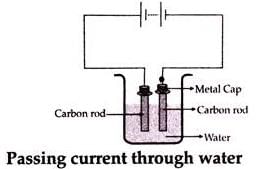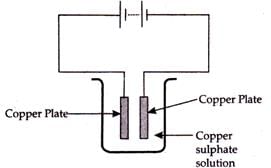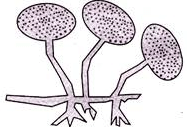Class 8 Science: Sample Question Paper - 8 | Science Class 8 PDF Download
Ques 1: Choose the correct options:
(i) Which is not a Kharif crop?
(A) Paddy
(B) Gram
(C) Maize
(D) Soya bean
Ans: B
Ques 2: Choose the correct options:
(ii) Which is not classified as major group of the micro-organisms?
(A) Bacteria
(B) Fungi
(C) Protozoa
(D) Plants
Ans: D
Ques 3: Choose the correct options:
(iii) Pick out the synthetic fibre from the following?
(A) Cotton
(B) Nylon
(C) Jute
(D) Wool
Ans: B
Ques 4: Choose the correct options:
(iv) Metals can be cut with a knife:
(A) Sodium and Iron
(B) Potassium and Copper
(C) Copper and Iron
(D) Sodium and Potassium
Ans: D
Ques 5: Choose the correct options:
(v) A black, tough and porous substance is:
(A) Coal tar
(B) Coal gas
(C) Coke
(D) Diesel
Ans: C
Ques 6: Choose the correct options:
(vi) Which one of the following has the highest calorific value?
(A) Kerosene
(B) Biogas
(C) LPG
(D) Petrol
Ans: C
Ques 7: Choose the correct options:
(vii) The Red Data Book keeps a record of all the
(i) endemic species
(ii) endangered plants
(iii) extinct species
(iv) endangered animals
(A) (i) & (ii)
(B) (ii) & (iii)
(C) (iii) & (iv)
(D) (i) & (iv)
Ans: C
Ques 8: Choose the correct options:
(viii) The jelly-like fluid substance present in cells is called
(A) Protoplasm
(B) Chloroplast
(C) Chromosome
(D) Cytoplasm
Ans: D
Ques 9: Choose the correct options:
(ix) In humans, the development of fertilised egg takes place in
(A) ovary
(B) testes
(C) oviduct
(D) uterus
Ans: C
Ques 10: Choose the correct options:
(x) Protruding part of the throat in a boy is called
(A) Voice box
(B) Larynx
(C) Adam's Apple
(D) All of these
Ans: C
Ques 11: (i) Write two physical properties of metals.
Ans: (i) Ductility and Sonority
Ques 12: (ii) Define pressure and write its formula.
Ans: (ii) The force acting on a unit surface area is called pressure.
Formula: Pressure = Force/Area
Ques 13: (iii) Name the part of the eye which gives colour to the eye.
Ans: (iii) Iris has different colours, so the iris gives its colour to eyes.
Ques 14: (iv) What is the other name of voice box?
Ans: (iv) Larynx
Ques 15: (v) Name the force that always opposes the applied force.
Ans: (v) Frictional force
Ques 16: (vi) Name the layer which is present outside the cell membrane in plant cell.
Ans: (vi) Cell wall
Ques 17: What are petrochemicals?
Ans: All synthetic fibres are prepared by a number of processes using raw materials of petroleum origin, called petrochemicals.
Ques 18: What are the characteristics of an ideal fuel?
Ans: Characteristics of an ideal fuel:
(i) It is readily available, cheap and can easily be transported.
(ii) It burns easily, has higher calorific value and does not leave behind any residue.
Ques 19: (i) Name the tool used with a tractor for sowing seeds in the field.
(ii) What is the advantage of using this tool?
Ans: (i) The tool used with the tractor for sowing seeds in the field is drill.
(ii) It protects the seeds from the damage caused by birds.
Ques 20: What is an ecosystem?
Ans: An ecosystem constitutes the plants, animals and Micro-organisms in an area along with non-living components such as climate, soil, river deltas etc.
Ques 21: Mention any two features that are seen in boys and girls each to distinguish them from each other at puberty.
Ans: Two-features seen in boys at puberty are:
(i) Growth of facial hairs.
(ii) Voice becomes hoarse.
Two features seen in girls at puberty are:
(i) Development of breasts.
(ii) Region below the waist becomes wider.
Ques 22: Answer the following:
(i) Which micro-organism is used in making curd from milk?
(ii) Which micro-organism is used for making bread?
Ans: (i) Lactobacillus is used in making curd from milk.
(ii) Yeast is used for making bread.
Ques 23: What is the full form of CNG and LPG?
Ans: CNG: Compressed Natural Gas.
LPG: Liquefied Petroleum Gas.
Ques 24: Define Tissue.
Ans: A tissue is a group of similar cells performing a specific function. Tissues together make an organ.
Ques 25: Complete the following chemical reaction: Carbon dioxide (CO2) + Water (H2O)→? Is it an acid or base.
Ans: 
Ques 26: What are the effects of force?
Ans: It is an acid.
Ques 27: (i) Differentiate between an asteroid and a comet.
(ii) (a) The planet which is farthest from the Sun is _____.
(b) The planet which appears reddish in colour_____.
Ans: A force changes or try to change the
(i) speed of a moving body.
(ii) direction of motion of a body.
(iii) shape of a body.
Ques 28: Mention three examples that show that friction produces heat.
Ans: (i)
| Asteroid | Comet |
| The gap between Mars and Jupiter's occupied by a large number of objects that revolve around the sun. | They resolve around the sun in more elliptical orbits. |
(ii) (a) Neptune
(b) Mars
Ques 29: List three sources of noise pollution in your locality.
Ans: Following examples show that the friction
Produces heat:
(i) Warming of our palms when we rub them.
(ii) Rubbing sticks together to produce fire.
(iii) Warming of the parts of a machine when it is operated.
Ques 30: Eyes of the nocturnal birds have large cornea and a large pupil. How does this structure help them?
Ans: The three sources of noise pollution in our
Locality are:
(i) Industries.
(ii) Television and music systems.
(iii) Transport, vehicles.
Ques 31: Level of air pollution is higher in metro cities. Mention the major causes responsible for this increase.
Ans: The size of the eyes of nocturnal birds is large. Large eyes with a wider pupil, larger lens and increased retinal surface can collect more ambient light which helps them to see the objects even at night easily.
Ques 32: What are the chemical effects of electric current? Explain with the help of an example.
Ans: Major causes of air pollution are:
(i) Emissions from automobile exhaust.
(ii) Effluents from thermal power plants.
(iii) Smoke from forest fires, volcanic eruptions etc.
Ques 33: What do CFC's stand for? Name some devices where CFC's are used. Why CFC's are considered as pollutants?
Ans: Chemical effects of electric current can be explained by following experiment:
(i) Take two carbon rods with metal caps. Clean their metal caps.
(ii) Wrap copper wires around the metal caps of the carbon rods and join them to a battery.
(iii) Pour a full cup of water in a glass bowl and add a teaspoon of salt.
(iv) Immerse the electrodes in solution but metal caps should be out of the water,
(v) Wait for 5 min.
(vi) Observe the electrodes,
(vii) The passage of electric current through a conducting solution causes chemical reaction. As a result, bubbles of gas are formed near the electrodes. Deposits of metal may be seen on electrodes. Change of colour of solution may occur. These are some of the chemical effects of the electric current.
Ques 34: What is electroplating? What are its advantages?
Ans: CFCs stands for Chlorofluorocarbons. CFCs are used in refrigerators, air conditioners, aerosol Sprays.
CFCs are considered as pollutants because these are depleting the useful ozone layer of the upper atmosphere. This happens as follows:
CFCs released into the air, go up and ultimately reach high into the atmosphere where the protective ozone layer exists. The Chlorofluorocarbons react with ozone gas of ozone layer and destroy it gradually.
This allows the harmful ultraviolet rays of the sun to reach on the earth and cause damage.
Ques 35: Explain the functions of plastids.
Ans: 
Electroplating is the process of depositing a layer of any desired metal on another metal by means of electricity.
Advantages of Electroplating:
(i) It is used to coat a desired metal on another metal.
(ii) It protects the metals from corrosion.
(iii) It also prevents the metallic surface from rusting.
(iv) Some cheap and dull metals are coated with costly and shinning metals for ornamental use.
(v) It can make more reactive metals like iron less reactive.
(vi) Coating of chromium on metals gives luster to objects.
Ques 36: Observe the figure and answer the following questions: 
(i) Name the micro-organism and the group to which it belongs.
(ii) Name the food items on which the organism grows.
(iii) Does it grow well in dry or in moist conditions?
(iv) Is it safe to eat infected bread?
Ans: The small colored bodies in the cytoplasm are called plastids. These are found only in plant cells but not in animal cells. Plastids are of different colours. Some of them contain green pigment called chlorophyll. The plastids having other than green colour are called chromoplast. Some plastids are colour less called leucoplast. These coloured plastids provide various colours to flowers and fruits. The chloroplasts having chlorophyll help in the formation of food by leaves through the process called photosynthesis.
(i) Micro-organism is bread mould (Rhizopus) and the group is Fungi.
(ii) Organism grows on moist and stale bread.
(iii) It grows well in moist conditions.
(iv) No, the fungus spoils the bread by producing poisonous substances (toxins).
|
90 videos|278 docs|44 tests
|
FAQs on Class 8 Science: Sample Question Paper - 8 - Science Class 8
| 1. What is the importance of studying Science in Class 8? |  |
| 2. How can I prepare for the Class 8 Science exam effectively? |  |
| 3. What are the main topics covered in the Class 8 Science syllabus? |  |
| 4. How can I improve my understanding of complex scientific concepts in Class 8 Science? |  |
| 5. What are some effective study techniques to remember scientific terms and definitions for the Class 8 Science exam? |  |


















